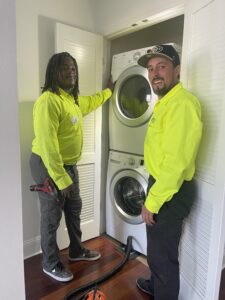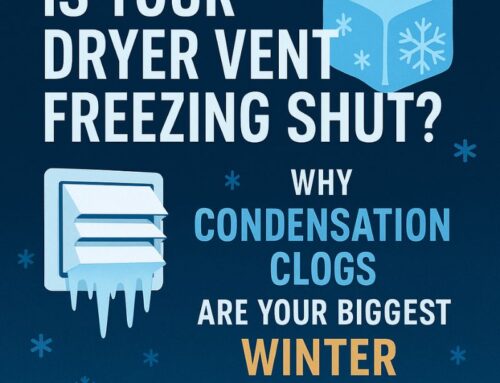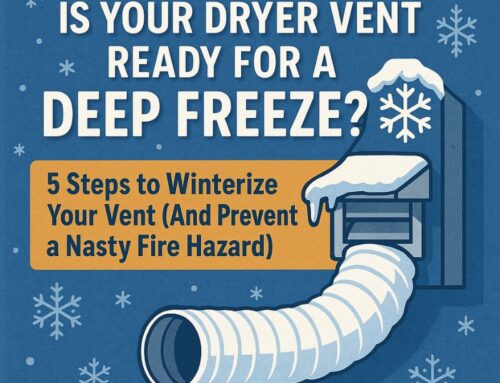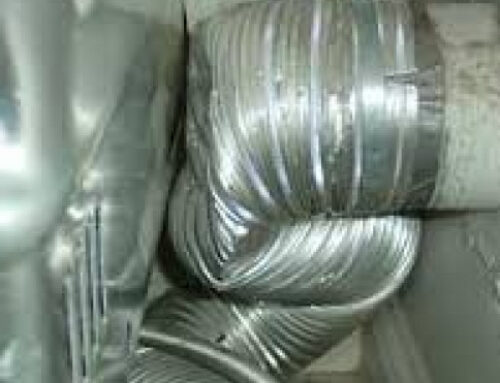Liability vs. Life Safety: Why Multi-Unit Dryer Vent Cleaning is Non-Negotiable
If you manage a multi-unit property in Colorado — whether it’s a condo complex, apartment building, or townhome community — dryer vent cleaning isn’t just maintenance. It’s fire prevention, legal compliance, and risk management.

Dryer vents might not be flashy, but when neglected, they’re one of the most dangerous systems hiding behind your walls. With longer duct runs, heavy usage, and shared infrastructure, multi-unit dryer vent systems pose a significantly higher fire risk than single-family homes.
As Fire Prevention Month rolls around, there’s no better time to reevaluate your property’s approach to multi-unit dryer vent cleaning. Because when it comes to liability vs. life safety, the choice is clear — and not optional.
Why Are Multi-Unit Dryer Vents More Fire-Prone Than Single-Family Systems?
Let’s get into the physics of lint (yes, really).
In multi-unit buildings, dryer vent systems face a perfect storm of risk factors:
- Longer duct runs: The further hot air and lint have to travel, the more likely they are to clog.
- More frequent usage: Tenants in units often run dryers daily, and commercial laundry rooms can have machines going non-stop.
- Complex vent layouts: Shared walls and ceilings mean vents often snake around corners and through multiple levels — reducing airflow and increasing lint buildup.
- Backdrafting risks: Poor vent design or damage can cause lint or moisture to push back into other units.
All of this leads to one thing: clogged dryer vents, which dramatically raise the risk of overheating and fire. According to the National Fire Protection Association (NFPA), dryers cause nearly 16,000 structure fires every year, the majority of which are due to lint accumulation.
Dryer Vent Fire Prevention: A Matter of Compliance and Responsibility
Fire prevention isn’t just about safety — it’s also about legal and insurance compliance. As a property manager or HOA, you’re expected to know and follow the rules.
Key Regulations and Guidelines:
- NFPA 211: Recommends annual inspection and cleaning of dryer vents.
- Local fire codes (including those adopted by Colorado municipalities): May impose stricter standards for multi-family dwellings.
- Insurance companies: Often require proof of regular vent maintenance — or they may deny fire-related claims.
- HOA bylaws: Frequently include dryer vent cleaning as part of required property upkeep (whether it’s the unit owner’s or HOA’s responsibility).
The Legal and Financial Cost of Skipping Maintenance
Ask yourself: What’s more expensive — a scheduled dryer vent cleaning, or…
- A fire-related insurance claim denial?
- An injured tenant filing a lawsuit?
- A destroyed building and displaced families?
Too often, commercial property owners roll the dice on maintenance — only to get hit with massive liability after the fact. Ignoring scheduled cleaning can expose your property to significant dryer vent cleaning liability, especially in the event of a fire, injury, or insurance claim denial.
Real Talk: What Could Go Wrong?
- Negligence claims if a fire occurs and cleaning logs are missing
- Code violations leading to city fines or failed inspections
- Rent losses during restoration and tenant displacement
- Skyrocketing insurance premiums after a claim
It’s not fear-mongering — it’s reality. As professionals in commercial dryer vent cleaning, we’ve seen what happens when maintenance gets deferred. Spoiler: It’s never cheap.
How Often Should Dryer Vents Be Cleaned in Multi-Unit Properties?
Great question — and one we hear often.

Here’s the general rule of thumb:
Property Type
Cleaning Frequency
Apartment Complex (individual units)
Every 12-18 months
Condos/Townhomes with shared vents
Annually, at minimum
High-volume shared laundry rooms
Every 6 months
Commercial laundry facilities
Quarterly or as needed
Of course, usage volume, system design, and layout can change the recommendation. That’s why Dryer Vent Techs offers customized plans — no one-size-fits-all pricing here. You only pay for what your building needs.
HOA Dryer Vent Cleaning Requirements: What You Need to Know
In Colorado, many HOA boards are increasingly being held accountable for safety-related infrastructure — even if dryer vent cleaning is technically the unit owner’s responsibility. Understanding HOA dryer vent cleaning requirements is critical for ensuring compliance, reducing shared liability, and keeping all residents safe.
Some questions you should be asking:
- Are your bylaws clear on whose responsibility vent maintenance is?
- Do you keep documentation of vendor visits and cleaning dates?
- Have you ensured unit owners are compliant (if it’s their duty)?
- Are you educating residents about warning signs like musty smells or long dry times?
Pro tip: Even if it’s the unit owner’s job, shared liability can still fall on the HOA. That’s why many associations are now scheduling community-wide cleanings — easier, more consistent, and far safer.
Fire Prevention Month: How to Take Action Now
This October, use Fire Prevention Month as your annual reminder (or friendly nudge) to get things scheduled.
Here’s how to ensure compliance and reduce risk:
- ✅ Schedule a dryer vent inspection for all units.
- 📋 Document cleaning for insurance and HOA recordkeeping.
- 🧰 Repair damaged or improperly installed venting (we do that too!).
- 📣 Educate tenants with flyers or email reminders about fire prevention.
- 📞 Call Dryer Vent Techs for a quote tailored to your building size and layout.
Let us help you get compliant and keep your residents safe — without breaking your budget.
Frequently Asked Questions (FAQs)
Q1: Can one clogged vent affect the entire building?
Absolutely. In shared vent systems, a clog in one unit can cause pressure backups and lint blowback into other units — a ticking time bomb.
Q2: Who’s responsible — the HOA or the unit owner?
It depends on your bylaws. But remember: even if it’s the unit owner’s duty, the HOA can still be held liable if no system is in place to ensure compliance.
Q3: What are signs a vent needs cleaning?
- Long drying times
- Overheated dryers
- Musty smell in laundry room
- Excessive lint buildup behind the machine
Q4: How long does cleaning take?
Most individual units take 20–45 minutes, depending on access. We work efficiently with minimal disruption.
Q5: Do you offer volume pricing or contracts?
Yes! We offer bulk pricing, flexible scheduling, and annual service contracts for HOAs, apartments, and property management companies.
Ready to Eliminate Risk and Stay Compliant?
Fire safety isn’t optional. Compliance isn’t negotiable. And neither is protecting your tenants, your investment, and your peace of mind.
Dryer Vent Techs is Colorado’s trusted team for multi-unit dryer vent cleaning, repair, installation, and inspection. No upsells. No guesswork. Just skilled technicians, clear pricing, and a job done right. Call today (720) 257-8155.
🔥 Fire Prevention Month Special: 10% Off Dryer Vent Cleaning
To help Colorado property managers, HOAs, and building owners take action this Fire Prevention Month, Dryer Vent Techs is offering 10% off all dryer vent cleaning services for a limited time.
🛑 Here’s the catch (and the reminder): You must call us directly and ask for the 10% offer to get the discount applied.
📞 Call (720) 257-8155 now to schedule your inspection and ask for the 10% savings — because protecting your property shouldn’t come with full-price risk.










